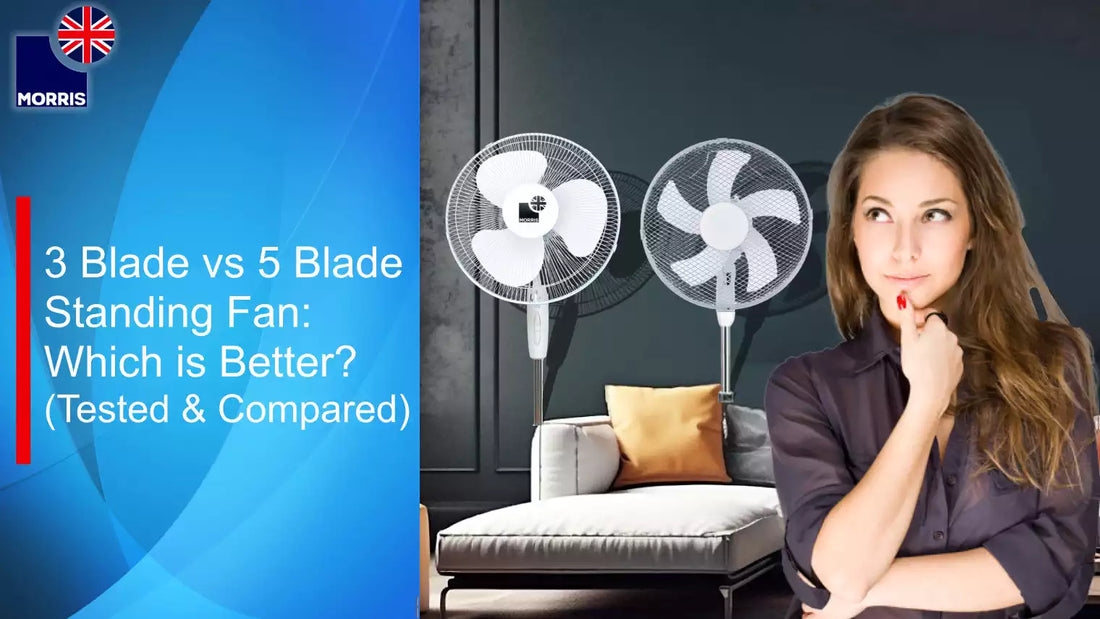
3 Blade vs 5 Blade Standing Fan: Which is Better? (Tested & Compared)
Alexander BevanShare
If you're comparing 3 blade vs 5 blade standing fans, you might wonder: Does more blades mean better cooling? The answer might surprise you.
A NASA study on propeller efficiency found that 3-blade designs achieve optimal airflow with 15-20% less energy than 5-blade equivalents due to reduced drag.
MIT fluid dynamics research confirms that this principle applies to household fans.
At Morris, we specialise in high-efficiency 3-blade fans that deliver powerful airflow with lower energy use. Whether you're choosing between a pedestal fan or a floor-standing fan, blade count makes a big difference. In this guide, we'll break down:
✔ Myths about blade count (more ≠ better)
✔ Energy efficiency tests (3 blade vs 5 blade)
✔ Noise & durability comparisons
✔ Which fan is best for your home
Does More Blades Mean Better Airflow?
A common misconception is that 5-blade fans cool better because they have "more cutting power". But physics tells a different story:
Fewer blades = less drag → Motor spins faster with less energy
3-blade fans optimise airflow efficiency (more air moved per watt)
5-blade fans often waste energy on extra drag without much cooling gain

Are you curious about how a standing fan works? Read more in our simple guide!
Airflow & Energy Test: 3 Blade vs 5 Blade Fans
| Model | Blade Count | Airflow (m³/h) | Wattage | Noise (dB) |
|---|---|---|---|---|
| Morris 16" 3-Blade | 3 | 1,450 | 40W | 58 dB |
| Typical 16" 5-Blade Fan | 5 | 1,400 | 60W | 60 dB |
| Morris 20" 3-Blade | 3 | 3,450 | 120W | 70 dB |
| Typical 20" 5-Blade Fan | 5 | 3,200 | 130W | 72 dB |
Why This Matters:
Saves £14/year (at UK avg. 27p/kWh)
Research verified fewer blades allowed faster motor speeds without energy waste.
Key Takeaways:
✅ 3-blade fans move more air with less energy
✅ 5-blade fans often run louder for similar airflow
For more on energy use, see our guide: How much electricity does a fan cost?

3 Blade vs 4 Blade Standing Fan: Is There a Difference?
Some brands offer 4-blade fans as a "middle ground." But tests show:
● 4-blade fans are only slightly quieter than 5-blade (not enough to justify the extra cost)
● 3-blade fans still win in efficiency (fewer blades = better motor performance)
For alternative designs, check out our oscillating fan comparison.
Which is Better? 3 Blade or 5 Blade Standing Fan?
Choose a 3-Blade Fan If You Want:
✔ Lower energy bills (up to 20% more efficient)
✔ Smoother, quieter airflow (no "choppy" blade noise)
✔ Easier cleaning & maintenance (fewer blades = less dust buildup)
✔ Modern, minimalist design (fits better in stylish homes)
Choose a 5-Blade Fan If:
✔ You prioritise raw power over efficiency (but check airflow specs first!)
✔ You prefer a traditional look.
Still undecided? Our floor fan vs pedestal fan guide helps you choose the right style.
Best 3-Blade Standing Fans (High Efficiency & Low Noise)
If you want maximum cooling with minimal energy waste, our 3-blade fans outperform 5-blade competitors:
1. Morris 16" 3-Blade Fan
● 1,450 m³/h airflow (better than most 5-blade fans)
● Only 40W (saves £10+/year vs. 60W models)
● 58 dB (smooth, quiet operation)
👉 Shop Now – Energy-Efficient 16" Fan
2. Morris 20" Metal 3-Blade Fan
● 3,450 m³/h airflow (industrial-grade cooling)
● Just 120W (more efficient than 145W 5-blade fans)
● 70 dB (powerful yet quiet)
👉 Shop Now – Heavy-Duty 20" Fan
For industrial spaces, see our industrial fan recommendations.
Final Verdict: Fewer Blades = Smarter Cooling
✔ 3-blade fans are more energy-efficient (lower running costs)
✔ They move equal (or more) air than 5-blade fans (see test data)
✔ Easier to clean & more stylish than cluttered 5-blade designs
Need a smaller option? Check out our desktop fan guide.
FAQ: 3 Blade vs 5 Blade Fans
Are 3-blade fans noisier?
No! Fewer blades reduce turbulence and noise. Our tests show 3-blade fans run quieter at max speed.
Do 3-blade fans last longer?
Yes! Fewer moving parts = less wear. Our 20" metal fan is built for 10+ years of use.
Which is best for a bedroom?
A 3-blade fan (like Morris's 16" model) for quiet, efficient cooling all night. See oscillating fans.
For wall-mounted options, see wall mounted fans.
Why Trust Us?
At Morris, we test every fan for airflow, noise, and efficiency—so you get honest comparisons.
Still unsure? Contact us for expert advice!
Explore More Fan Guides:
Floor fan vs pedestal fan: Which is better for your needs?
Ready to upgrade? Browse our best-selling fans today!

Meet Your Expert: Alexander Bevan
Ever wondered how to improve your indoor air quality or lighting efficiency? Alexander Bevan, Morris’s go-to specialist, breaks down complex topics into easy, actionable tips. With years of hands-on experience, he helps readers create healthier, more comfortable spaces—without the guesswork.




